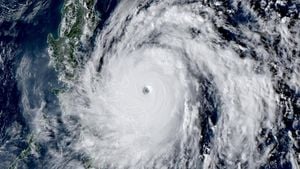South Africa finds itself at the center of a gripping and complex rescue operation as illegal miners, often referred to as 'zama-zamas,' remain trapped beneath the earth, caught between the perils of illegal activities and the desperation for survival. Authorities have recently taken significant steps to address the situation, developing new strategies aimed at safely bringing these miners back to the surface.
The operation intensified when government officials closed off access points to the disused gold mine near Stilfontein, located just southwest of Johannesburg. This measure was part of what was referred to as the "Close the Hole" initiative—an aggressive government response to illegal mining activities. Initially, estimates suggested up to 4,000 miners might be trapped underground; yet police later revised this figure to about 400, indicating the situation might not be as dire as initially thought.
Concerns about the safety of the miners have sparked significant debate within the community, as government officials have escalated their efforts to secure the area and prevent supplies from reaching those below. The drastic closure of miner access points—including supplying food and water—was intended to “smoke out” the miners, forcing them to surrender to the authorities. Unfortunately, this strategy led to tragic outcomes, with reports of illnesses and deaths among miners who could not withstand the prolonged lack of resources.
On November 14, amid these worrying conditions, the lifeless body of one miner was recovered, raising the stakes for those still trapped. The authorities’ response involved various community consultations to establish not only the number of miners still underground but also to navigate the delicate balance between law enforcement and humanitarian efforts.
Senzo Mchunu, South Africa’s Minister of Police, acknowledged the complexity of the situation. “We need to prioritize their lives—hasty measures can lead to more harm than good,” he stated during his visit to the site, highlighting the dire conditions faced by those trapped below. Mchunu’s task force consists of various stakeholders, including police, mine safety experts, and the South African National Defense Force, all collaborating to form comprehensive plans to safely extricate the trapped miners.
Local family members of the miners have shared their anguish and fears. Priscilla, whose partner managed to escape but whose family members remain trapped, expressed her hope yet called for urgent government action: “We’ve heard of bodies being pulled out, and I don’t know if they are alive. My heart aches knowing they are down there.” This sentiment was echoed by community members, some of whom feel abandoned as the government seeks to enforce laws over empathy.
The humanitarian aspect of this crisis cannot be overstated. Activists and relatives are drawing attention to the risk of starvation and hypothermia facing the illegal miners, questioning whether the authorities have forsaken their humane duties. Xuna, another community member, challenged officials to understand the depths of despair faced by those below ground: “How can they sleep at night knowing children are starving underground?”
Following criticism about the initial strategies employed, the South African government is adopting a more conciliatory approach. This includes forming rescue teams comprised of community members, technical rescue professionals, and social workers dedicated to both extraction efforts and psychological support for those rescued. The recent court rulings have also underscored the need for lawful, ethical handling of the situation, which weighs heavily on many community hearts currently divided between fear of criminalization and hope for survival.
Legal and ethical responsibilities are under scrutiny. The South African Human Rights Commission (SAHRC) decided to investigate allegations of neglect—specifically claims stating police had denied food, water, and medical attention to the illegal miners. This inquiry seeks to assure families and communities impacted by these operations are treated with dignity and respect.
Efforts on the ground are changing rapidly. Family members and residents have started using makeshift means such as ropes for their rescue attempts, at times with police either supporting or observing such grassroots efforts. Activist groups such as the General Industries Workers Union of South Africa (GIWUSA) have coordinated local campaigns to deliver food to the miners, aiming to sustain those still below and facilitate their safe exit.
The government’s operations have yielded some troubling findings, with authorities reporting the retrieval of 369 firearms alongside large sums of cash and uncut diamonds from older mining sites. These revelations point to the multifaceted nature of illegal mining—the intersection of poverty, crime, and desperation—further complicates the rescue and recovery operations. Police spokesperson Brigadier Athlenda Mathe has emphasized the need for balance between law enforcement and responsible rescue methodologies.
With heavy machinery and mine safety teams now planning assessments of the situation, the focus has shifted not only to extraction but also to developing longer-term strategies to reduce illegal mining among vulnerable populations. This transition indicates the state is aware of the socio-economic factors driving individuals to risk their lives underground.
Advocates for change, including civil organizations and family members, have begun to call for more than just rescue; they argue for comprehensive economic opportunities and policies to address the root causes leading to hazardous illegal mining practices. “It’s not just about bringing them back; it’s what we do afterwards to prevent them from going back down there,” expressed one community leader.
At present, the situation continues to evolve as rescuers strategize intensively. The coming days will determine not only the fate of those still trapped but also the future of mining policies and local engagement in South Africa. This operation reflects the underlying tensions within society: the struggles for safety, survival, and the right to exist within both legal and illegal bounds.
What remains crystal clear is the urgent need for compassionate and effective action. The resolution of this crisis will resonate far beyond the depths of the mine, shaping conversations about human rights, socio-economic policies, and the resolve of communities grappling with persistent economic challenges. Will the government rise to this occasion with humane intent, or will the system subject its most vulnerable to more punitive measures? Only time will reveal the answers to these pressing questions.



